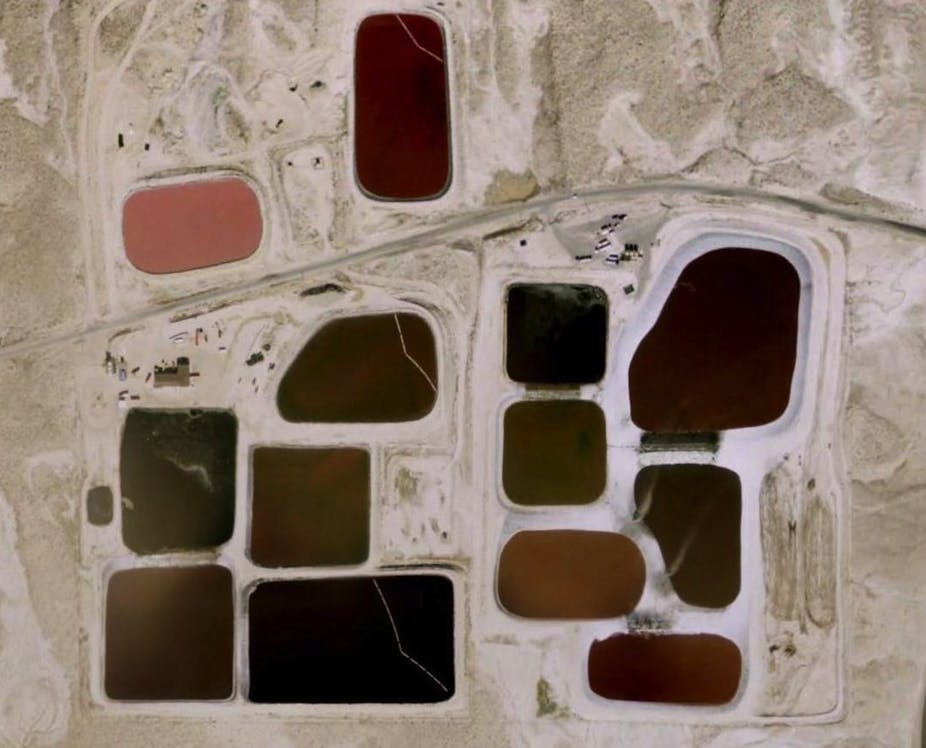The Coal Seam Gas (CSG) industry constitutes an interesting opportunity for Australia. We could get a lot of positive things out of CSG. But it does produce a lot of “waste water”: if things go badly there could be some negative effects.
The CSG industry has developed at such a rapid pace that stakeholders sometimes have had a hard time catching up to the potential environmental effects associated with development of this resource. But industry and government regulations have been constantly improving.
Coal seam gas is a very important industry in Queensland, it provides a lot of jobs and resources.
How it works
Coal seams are essentially aquifers that contain appreciable quantities of water. The methane gas in coal seams is held in the micropores of the coal by water pressure.
To get the gas out of the coal seam units, CSG operators depressurise the coal aquifer system by pumping water from these units to the surface.
In this way, the gas diffuses from the micropores and flows with the water through coal cleats which are small cracks that naturally occur within the coal structure. Water and methane will then flow through the coal aquifer system towards CSG wells that are actively being pumped.
Methane does not dissolve very well in water so as soon as the bubbles reach the well, they separate. Typically, there is a pipe that collects methane gas and delivers it to the surface and another pipe from which CSG water is pumped up to the surface.
There could easily be more than a thousand CSG wells operating in Queensland now. In 2009/10 the Bowen and Surat basins in Queensland produced 212 petajoules of gas – more than enough to supply Brisbane with gas for a full year.
Some of the gas is used locally in Australia but an important surplus is exported to Asian countries.
It is a good business, but there are potential environmental issues that could arise due to CSG water abstraction.
Current total water production from all of the CSG wells in Queensland could easily be over 10,000 megalitres per year. That’s more than two and a half thousand Olympic swimming pools.
Water, water everywhere. What a waste.
So to understand what the potential environmental effects could be it is important to understand both water quality and quantity issues.
It’s a tremendous amount of water, and this is a shame as Australia is one of the driest continents on the planet: that’s worth thinking about.
The implications of CSG water abstraction could entail undesirable aquifer depressurisation within aquifers used by farmers and other groundwater users. But this activity is heavily scrutinized with adequate modelling and monitoring.
CSG producers are not allowed to use this water outside their permit areas unless it complies with specific guidelines released by the government.
Before that, they weren’t allowed to use it at all and the water was being stored in ponds on the surface. So what to do with all that waste water?
In Queensland, one of the preferred choices is to inject CSG water into shallow aquifer units after it’s been treated. It’s a good strategy, because by doing so important aquifers are recharged with water that can be used later on. That’s a very elegant way of dealing with the problem.
Unfortunately this is not a very cost effective process. Injection is expensive and conventional treatment with reverse osmosis also costs a lot.
So why not use it for irrigation?
CSG waters tend to exhibit similar quality in terms of salinity and major ion composition. Their salinity varies depending on aquifer depth and proximity to recharge areas. Their major ions are sodium, bicarbonate, and sometimes chloride.
Overall, these waters tend to be fairly alkaline with low calcium, magnesium, and extremely low sulphate concentrations.
The main issue with these waters is their elevated sodium content, which in conjunction with their low calcium and magnesium concentrations, can generate soil infiltration problems in the long run, as well as short term toxicity effects in plants due to the sodium ion itself.
If the water is not very saline, it can be used to irrigate crops whilst taking care that the sodium levels are not high enough to damage soils.
If it’s managed properly, it’s a good option that should be considered by stakeholders. In addition, it is possible to reduce sodium ions (thus reducing the potential for soil damage) by treating the water with ion exchange technology, which can be done at considerably low costs.
There’s also the potential to use it for other purposes such as water for stock, dust control in unpaved roads and around mines. There’s also talk of using it in fisheries.
Avoiding disaster means better regulation
CSG producers normally produce scientific estimates and models to figure out how much gas they can extract from specific areas.
Generally, they also produce groundwater models to estimate the amount of CSG water abstraction that is required in each of their fields. They are coming up with these assessments independently and proactively.
But due to the nature of the way they conduct their business, they normally don’t produce these models collectively.
Operators and government are now working towards producing conjunctive groundwater models to estimate the potential aquifer depressurisation effects due to collective CSG water abstraction.
So regulation is being implemented at a wider scale. The collective effect of all the pumping that goes on in a particular area must be considered.
With good regulations CSG waters do not need to be regarded as a waste but as an important resource. With treatment or good water and soil management practises, CSG waters can become an additional supply of water.

